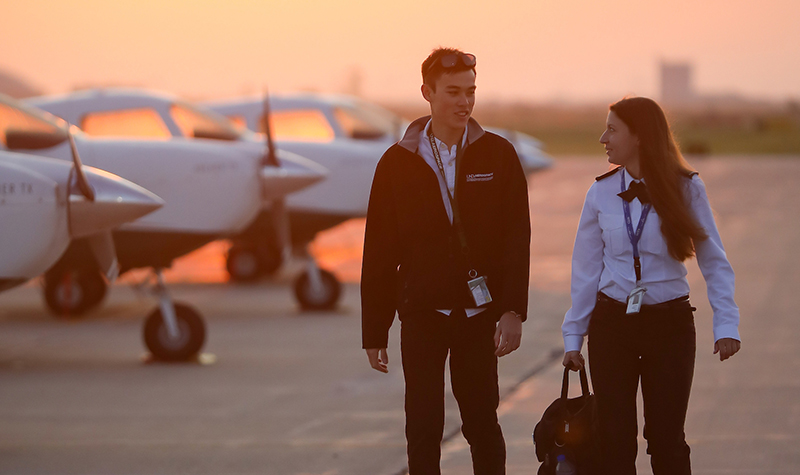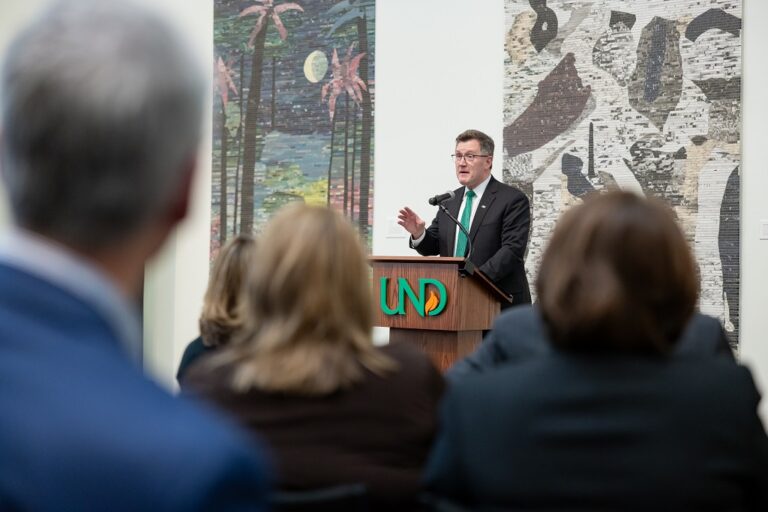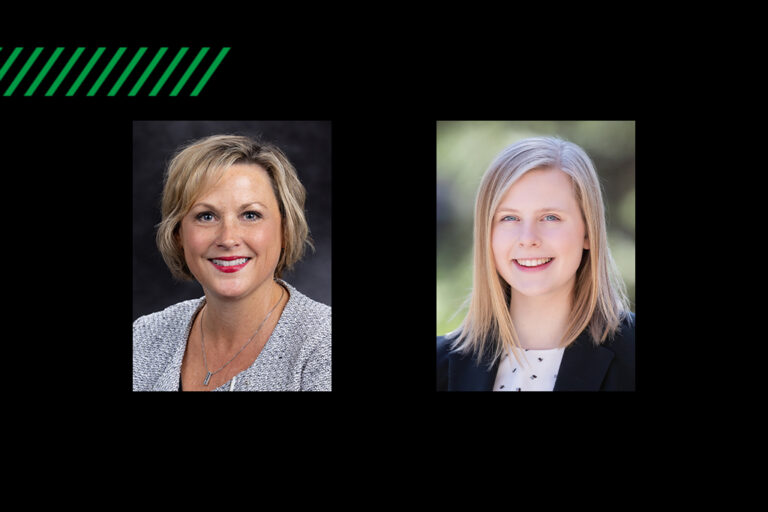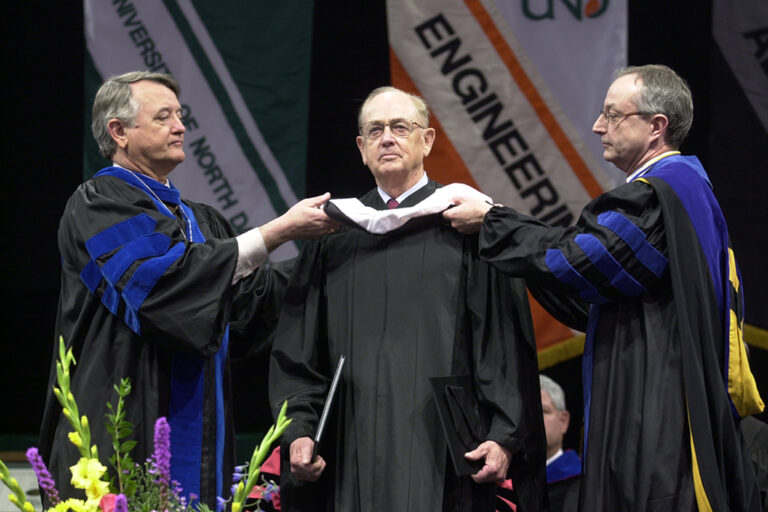Pathway partnerships create careers for UND’s aspiring pilots
With 17 “Pathway” programs on campus, aviation industry vies for competent, qualified pilots amid shortage

Competition is fierce at UND’s John D. Odegard School of Aerospace Sciences – but not between students.
Instead, the competition is for students, between airlines and other aviation giants hoping to recruit the students as the next generation of pilots.
Among major airlines, hiring pilots hit rock-bottom during the Great Recession 10 years ago, but the upswing since then has been dramatic. A key force behind that upswing is a rapidly aging workforce. United Airlines recently announced half of its 12,500 pilots will retire over the next 10 years.
And according to estimates from Boeing, reported by CNBC, airlines worldwide will need to recruit 645,000 pilots through 2038.
Many of these retirements will be prompted by a mandatory retirement age from the Federal Aviation Administration. It’s not just airlines, as freight, corporate and military flight operations abide by similar rules.
As carriers dramatically increase compensation and dig deeper into pools of potential employees, they’re partnering with flight schools such as UND Aerospace to streamline the job-hunting process for pilots-in-training.
“Opportunities have been exploding since economic recovery started ramping up in 2011,” said Chester Fritz Distinguished Professor Kent Lovelace, the school’s director of aviation industry relations and a person who’s had his finger on the pulse of the aviation industry throughout his near-40-year career at UND Aerospace.
Lovelace’s years of research alongside UND faculty warned industry stakeholders of pilot shortages early in the decade, when hiring was still frozen.

Pathway options increase alongside enrollment
As hiring has recovered, enrollment at UND Aerospace has soared. Just from 2018 to 2019, the number of commercial aviation majors went up 8.2 percent.
“In the 20 years I have been in aviation education, I have never seen this many unique Pathway programs for our students,” Associate Dean Elizabeth Bjerke said. To date, there are 17 such programs at UND: defined paths laid out by commercial carriers, companies and agencies for pilots-in-the-making to develop their careers.

Though the same certifications and amounts of flight hours are required, Pathway programs let aviation students go through application and interview processes while still attending school. Some programs accept applications from students as early as their sophomore year.
Most programs offer conditional employment to successful applicants. If they maintain good academic standing and abide by a program’s guidelines, their placement in an entry-level pilot position is secured following graduation. That position usually is with regional or corporate carriers, where pilots typically build total flight time to become eligible for first officer positions at major airlines.
The first carrier to bring such a structure to UND was JetBlue Airways more than 10 years ago, in 2007. Bjerke said many alums have since followed that “Pathway” and now fly as first officers for the airline.
“It was truly a way to help connect and mentor students throughout their career progression,” said Bjerke.
In September, JetBlue returned to campus to unveil an updated Pathway option specifically for UND. The Certified Flight Instructor (CFI) Gateway program presents a new means by which graduates can accrue flight time while helping UND with its need for instructors.
The recent development came through collaboration and JetBlue’s understanding of UND’s unique challenges, Bjerke explained. As enrollment numbers at UND Aerospace rapidly expand, chasing aviation hiring trends, more instructors are required to prepare undergraduates. But because opportunities abound, it’s hard for the University to retain qualified instructors.

Students accepted into JetBlue’s program can now apply to stay at UND as an instructor, then go directly to JetBlue as a first officer after accruing 3,000 – 4,000 hours of total time. Typically, graduates in the original JetBlue Gateway Program would spend a year at UND instructing before going to regionals such as Cape Air or ExpressJet to gain flight experience.
“This will allow us to retain highly experienced flight instructors to teach our most advanced flight courses for a longer period of time,” Bjerke said. “This is very much needed for our program.”
Lovelace, who continues working with airlines and other industry partners to develop opportunities for students, said those who stay at UND for such an extended period will need experience in advanced instructing before they progress to JetBlue.
“They’ll need not only the certifications, but experience instructing on multi-engine aircraft and our jet transition course in the simulator, among other lead instructing duties,” he said. “Teaching primary students for 2,000 hours isn’t going to float, and it’s a big jump to go from UND to JetBlue with regard to knowledge, experience and skill. That’s why there are requirements for advanced, higher-performance instructing.
“We’re able to provide that at UND.”
More than airlines
Bjerke was eager to point to another type of Pathway opportunity that has already come to fruition: the Air and Marine Operations Pathways Program.
Established in 2017, the U.S. Customs and Border Protection (CBP) career program recruits UND pilots of all types — fixed-wing, helicopter and UAS — for federal positions as air interdiction agents responsible for protecting the nation’s borders. U.S. Sen. John Hoeven, R-N.D., developed the program with CBP, which worked exclusively with UND in its inaugural recruitment run. By the end of the year, 15 students had been selected for training.
Bjerke said that one of those students is already back in Grand Forks, flying for the CBP’s local National Air Security Operations Center.
“There are more [pilot] opportunities in the military than there ever have been,” said Lovelace. All areas of flight have been affected by the scramble to recruit the best and brightest.
According to a student survey, almost a third of respondents indicated they were pursuing or had been accepted into a Pathway program at UND.
While less data is available about how the growth of career development partnerships affects things such as student retention and recruitment, Lovelace said the industry is reaching out in ways it never has before. Regional carriers are boosting their recruitment budgets and trying to create more social engagements. National carriers such as United and Delta want to have a regular presence on campus, to keep their names in front of students.
Lovelace encouraged students to look into career pathways and find what might be the right fit. While they aren’t necessarily fast lanes to first officer positions, they represent the quickest and surest routes to an airline pilot’s career.
“Students need to keep their noses clean, dot their i’s and cross their t’s and gain the experience,” he said. “Most of them will lead to a job with a mainline carrier.”



